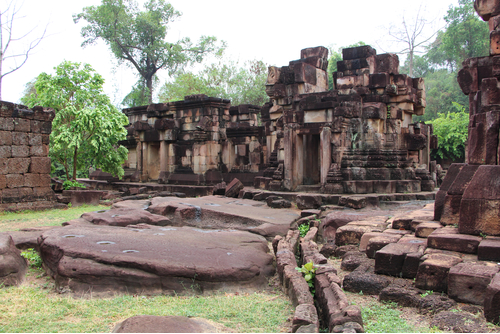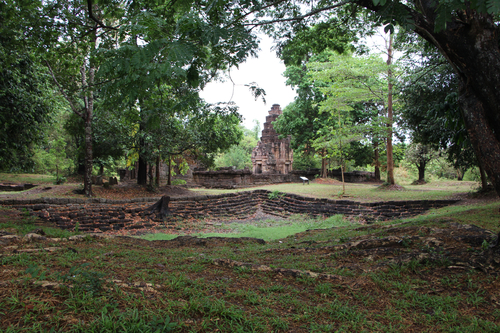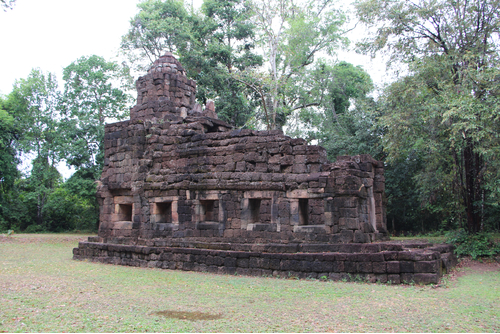Artwork Search
Arts in Southeast Asia Database
ArchitecturePrasat Ta Muen Thom
Prasat Tamuenthom are 3 large prasats built with sandstone and laterite. The group of prasats consists of a large principle prasat with recessed corners located in a square diagram. In a room at the center enshrines a Shiva lingam which is a symbol of Shiva, the supreme deity of Shaivism in Brahminism. This Shiva lingam is adorned from a natural sandstone. Later a prasat was built to cover it. It is assumed that this is a lingam that naturally appeared, called "Swayambhu lingam", which is the most important of Shaivism. There are 4 doors and the southern door is connected to the porch in the front or the Mondop. It is divided into 3 booths and the roof is made of sandstone. The base engraved a pattern of a standing idol. A sandstone lintel engraved a deity sitting in a knee-high position above the Kala face who is spitting out a bunch of garland was also found.There are 2 smaller prasats built of sandstone located behind the left and right sides of the principle prasat. The diagram is a square with receded corners. The entrance and exit is on the south and the other 3 sides were made of false doors.There are 2 laterite Bannalais. One is located in the south side of the principle prasat in a rectangular diagram. The other one is located in the south-west side in a square diagram.The principle prasat, the other 2 prasats and the 2 Banalais are surrounded by a crooked balcony. The gopura was built of sandstone in a square diagram. There is a 1.40 meter wide corridor with a gate on all four sides. The northern, eastern and western arches are similar while the arch on the southern side is the largest and it is the main arch, divided into 3 booths. The central booth is in a cross-shape diagram. There is a window with a stone balustrade attached. There was a discovery of a stone inscription inscribed with ancient Khmer and Sanskrit letters which were used in the late 16th century B.E. The detail in the inscription praises Shiva and also refers to the names of the slaves and the guardians of this religious place. A sandstone pier was also found in the south about 10 meters away from the balcony, and the pond was lined with laterite down to the bottom. It is located in northwestern side of the crooked balcony.
ArchitecturePrasat Ta Muan Tot
Prasat Ta Muan Tot is a chapel “Arogayasala”. It was built to treat diseases during the reign of King Jayavarman VII during the 18th century B.E. The architectural elements of the Arogayasala are the same everywhere. There will be one principle prasat made of laterite and sandstone. It is a square diagram with recessed corners. The top part was carved with sandstone in the lotus petals pattern. There is only one entrance and exit, the other 3 sides are false doors. The entrance was made as a long room with a porch in the front. The roof was made of sandstone and laterite. There is a Banalai in a rectangular diagram built from sandstone and laterite on the east of the principle prasat. There is one entrance and exit. The eastern area is surrounded by an inner wall and under a laterite arch door that is divided into 3 booths. A stone inscription, built around the 18th century B.E., inscribed in Khmer letters, Sanskrit language was found around the booths and it is currently at Wachirayan Book Hall, Bangkok. The inscription mentioned Phra Phaisachayaguru, the Bodhisattva who granted people a healty life. It also stated that King Jayavarman VII donated materials and equipment and arranged staff to stay in the hospital as well. The north-eastern side of the prasat appears a pond.
ArchitecturePrasat Ta Muen
The diagram of Prasat Ta Muen is a characteristic of an archaeological site called "Dharamshala or a traveler's lodge" which King Jayavarman VII, around the 18th century, had ordered to build along the important routes throughout the kingdom. The place is a single prasat constructed with laterite and sandstone. The diagram is a square with recessed corners. The front of the prasat is a long room built of laterite. There is a door connected to the prasat on the west. This long room has one wall cut into a row of windows. Other walls were made of false windows. There is one entrance and exit on the east with a sandstone lintel carved into a Buddha image sitting cross-legged in a meditating position.




